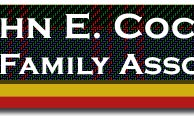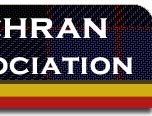Doumecq - 1900 - 1920
By Zenna Elizabeth Cochran Higgins
The building of the handsome house on Doumecq was the culmination
of John E. Cochran's dream in 1898 when he first saw the land he
wanted. A canyon at one end of the fertile quarter section offered
protection from the bad weather. A spring provided sweet water for
the house and cattle. Someone else had built a log cabin by the
spring but left before satisfying homestead requirements. John filed
with the county auditor to preempt the claim.
He established his wife, Emma, six daughters and year old son in
Whitebird so the girls could go to school. The family moved to
Doumecq in the summers for two or three years.
The log cabin had two rooms downstairs and two up. There were
cracks in the floor upstairs through which one could keep track of
what was happening below. Homemade bedsteads with slats for springs
and straw ticks for mattresses were for the 'girls who slept
upstairs. Emma and John with baby Robert slept downstairs on a
feather bed. This was covered in the daytime with a beautiful quilt,
either Turkey Tracks or Irish Chain which had been given to John by
his sisters when he left Tennessee to come west. The second summer
Robert was moved upstairs to make room for baby Ruth, born in
Whitebird the previous winter.
The house was too small for 10 people. As soon as he could get
the lumber John built a shed along the west side of the log cabin
for a kitchen and dining area and a very small bedroom for himself
and Emma. This left a bed for guests, traveling salesmen,
prospectors, ministers, the Raleigh agent, once a traveling dentist
and once the photographer who took the family picture.
Zenna was about four the first summer they spent on Doumecq.
Memories of the terror of riding up the steep mountain is fainter
now, but the trip up is all that she remembers of that first summer,
sitting behind one of the big girls, clutching her tightly around
the waist, expecting to slip off the horses' rump any moment. She
could scarcely venture a glance to see if Mama and baby Robert were
safe in the wagon. She knew that Papa walked beside the wagon, ready
to put a rock behind the wheel when the horses need to rest. John
maintained the two homes for a couple of years, commuting to
Whitebird weekends to see his family and attend Church and Sunday
school.
Zenna's first school year was at Whitebird with lovely, Cousin
Flora Kittrell her teacher. At recess Zenna stayed in to read a book
to be near her idol. When teacher came to dinner and told Mama how
Zenna loved to read and Zenna never corrected her. By the end of
that year Doumecq had enough families with children to support a
three months school. The county required eight children to start a
school in a rural district. There were four or five Cochran's and
four Shinn's, a scattering of Twogood's, Barker's, Ripley's and
others. Robert and Ruth were too young. Ethel may have attended
school that summer with Mary, Omie, Inez and Zenna. John then moved
his family to the homestead permanently. Edna who was about 17 had
finished the 8th grade in Whitebird. Edna took the teacher's
examination at Grangeville and was hired to teach the Doumecq School
for three months at a salary of $40 a month. To supplement the girls
education Emma, who had been a teacher, taught the five girls their
lessons at home in winter after the dishes were washed, the floor
swept and the beds made.
Sidney was born in 1900. To make more room, a good cellar was dug
and a room built above it for the hired man. This would not be
changed when the new house was built. Potatoes, apples, cabbages and
rutabagas would not freeze and would keep all winter. A shed was
added to the south with long and narrow shelves on both sides and a
door from the kitchen and one that opened to steps to the cellar. A
shed was added to the existing shed on the west for a kitchen with a
porch for the pump. A well had been dug and the spring was now used
only for watering the stock,
The porch which had been added on the east side of the log cabin
was a favorite place to sit on warm summer evenings. Some child
would say, "Papa, tell about when you were a little boy."
The children listened spellbound, night after night to the same
stories. The pleasure of the evenings is remembered but not a single
story. John was able to make the ordinary happenings of every day
exciting when he told of them on winter evenings he read aloud while
the girls and Emma sat around the crowded living room sewing carpet
rags, piecing quilts, or knitting.
When he was only four Robert's overpowering desire was for a gun.
His father told him he could have & gun when he was 21. He made
a little song which he chanted constantly to the consternation of
his sisters. The song was short and to the point, "When I am
21. I can have a gun." Of course he did not have to wait that
long. He and Boots Shinn went hunting when they were about 12 or 13.
Once, Boot's gun accidentally discharged shooting his toe. Robert
was always careful and never had an accident. He was a good shot but
was not allowed to hunt alone. Omie was his favorite companion when
a buddy was not available. She could spot a grouse almost hidden in
the bushes and was as good a shot as he, but with only one gun they
had to take turns. She was six years older than Robert. When it was
his turn she knelt so he could steady his aim over, her shoulder and
hit the grouse in the head. They usually brought a grouse or two
home from a. hunt. Being victorious hunters they turned the grouse
over to admiring sisters to clean and cut into enough pieces so
everyone had one. Grouse was the favorite meat of the entire family.
After a really successful hunt a minor family member might get even
a wing as well as a drum stick.
The nearest neighbors, the Canfield's had the post office. Inez
and Zenna were often sent for the mail. Mr. Canfield was a nice old
man who looked a little like Santa Claus. Inez and Zenna were about
the same size, wore their hair in pigtails and dressed alike, Mr.
Canfield could not tell them apart so called them both Zina.
Fortunately Inez and Zenna no longer wear their hair in pigtails,
are the same size or dress alike so that they are more easily
distinguishable.
When Canfields sold their place to Jim Campeau, Emma became
postmistress. Another small shed was added on the north side of the
house to accommodate the post office. Cubby holes held each
neighbor's mall and there was a counter and some space for freight
and parcel post. Anyone could run down and handout the mail although
the younger ones were not encouraged to do so except in emergencies.
Letter postage was 2 cents. Emma's pay was the stamps she cancelled.
A new house was planned from the beginning. John wanted a porch
all the way around it, and also a big entry hallway with a wide
stairway with a landing and window half way up. There would be a
bedroom for Omie and Mary, one for Inez and Zenna, and a smaller one
for Ruth. The two boys shared a room in the back and a big
unfurnished room over the kitchen could take any overflow. After the
house was built, four or even six girls would occasionally sleep
crossways on one bed for after a party conversation.
Lumber was hard to come by. As John had an interest in a small
sawmill he collected choice lumber slowly for the new house.
Everyone on Doumecq needed lumber for a new house, a barn or an
extra room. When a neighbor needed a few hundred feet to finish a
project John could not refuse to lend or sell it to him.
Consequently the new house was not built until the fall of 1915.
As the new house was to be built on the same spot as the log
cabin had to be moved into the woodshed where the family would live
until it was finished. Zenna helped move important things to the
cellar, woodshed, smoke house and wherever there was shelter. She
stored boxes carefully in an orderly manner and went off to Whitman
College. When she came home in June, the house was finished, the
family was moved in. Some things were never seen again and Zenna
took the blame, However, what couldn't be found was soon forgotten.
The new house was a huge success, impressive, big enough for a
family of 11. Only three children remained at home, but summer times
presaged return of the teachers, college girls and their friends.
Claribel Ingle, who graduated with Omie from Lewiston State Normal,
came for over a year to recover from a nervous breakdown. She was a
great favorite with everyone.
Mary and Omie each had a homestead on the breaks of Rice Creek.
They had to spend the summers living there to be able to prove up on
their homesteads. They always came up to see the family once a week
for supplies and to help with the work and stayed for five or six
days. Edna and Ethel married local men and were living on Doumecq.
When Edna or Ethel came to visit they always brought their beautiful
and talented children to entertain their spell bound relatives. They
never could stay long because of livestock and farms to care for.
The seven girls all eventually met and married their prince
charming and enjoyed motherhood. The boys slew dragons, married the
maidens for whom they slew them and fathered children. All of John's
26 grandchildren grew up to be good, healthy and honest citizens, a
source of great pride and conversation material to him, as they are
to their admiring and adoring aunts, uncles and parents. Doumecq is
still a place of romance, a symbol, a fairy tale place for the
children, grandchildren, great grandchildren and great, great
grandchildren of Emma and John E, Cochran
Reprints from Cochran Chronicles Volume 5, Number 1, June 1, 1982
© JECFA 1982
After Doumecq
More about Zenna
Up







